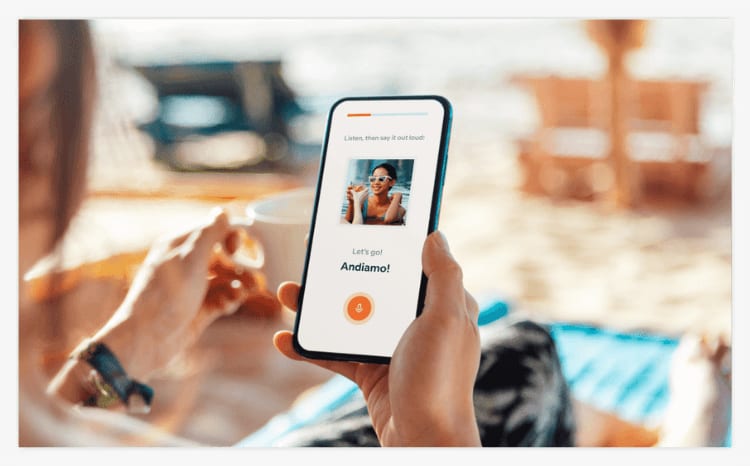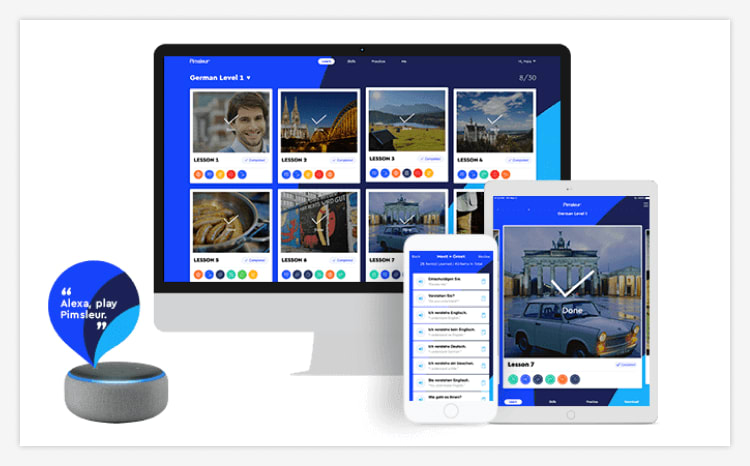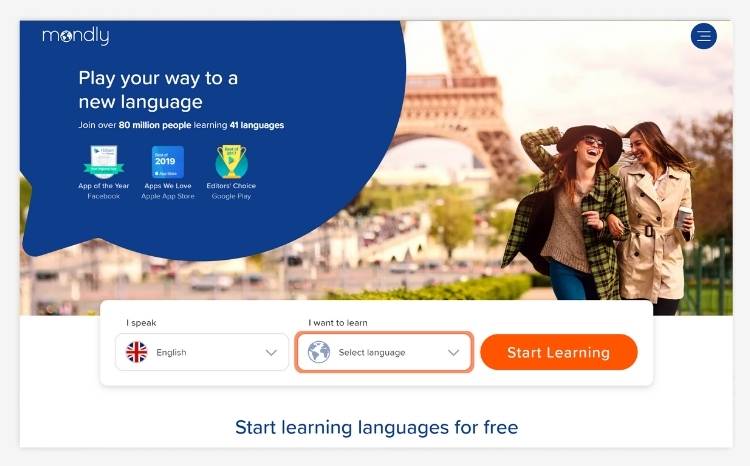

- Get up to 55% OFF your subscription
- Researched method built by 200+ experts
- Have conversations in as little as 3 weeks
- Award-winning 10-minute daily lessons


- 51 languages available
- Learn on-the-go with 30-minute lessons
- Start risk-free with a 7-day free trial


- Science-backed German teaching techniques
- Over 100 million users worldwide
- Save 96% on a lifetime subscription


- 25 languages available
- Speech recognition technology
- Limited time offer: Save up to 58% on plans


- Video-based flashcards to review the material
- Learn via subtitles and flashcards
- Up tp 70% off + 7-day free trial
The Top 10 Best German Learning Tools 2025
Learning German is a big and exciting project. Whether you’re learning for work, travel, or just for fun, it’s important to find the right tools to help you along. But finding the right one can feel overwhelming, especially with so many apps and resources to choose from. In this article, we highlight 10 of the best ways to learn German to help you get started on your German-learning adventure.
What are language learning tools?
Language learning tools can help you master the key skills you need to reach fluency. Some tools focus on the building blocks of language, such as vocabulary or grammar. Others will give you access to reading, listening, or audiovisual material in your target language. To take your speaking abilities to the next level, some tools also connect you with virtual teachers for conversation classes and interactive lessons. You might need to use a few different tools to uplevel your language abilities across the major skills.
Why use German learning tools?
In the past, language learners were restricted to a few scant resources. From heavy dictionaries to dense grammar books, they were difficult to use on the go. And while in-person classes and courses still have a lot of value for learners, they can be expensive and a big time commitment. By contrast, online German learning apps give you the opportunity to study at any time, and costs are usually much lower (or even free).
They can also bring learning to life, with multimedia resources that can make memorization and language practice much more stimulating. Many German learning apps use techniques rooted in neuroscience and educational research to ensure you’re getting the best results. There are even tools that can connect you with other learners or native speakers, making German learning less of a solitary pursuit. Even if you’re not able to visit a country where German is spoken, you’ll still have plenty of opportunities to engage with authentic material and practice the key skills.
What types of German learning tools are there?
When it comes to German learning apps, you’re spoiled for choice. Many apps focus on vocabulary acquisition and memorization, but how they approach this will depend on the software. Some go for a spaced repetition approach, similar to flashcards. These will help you embed vocabulary by cycling the words you’ve learned so you’re exposed to them frequently over a period of time. Others will integrate vocabulary into short phrases, sentences, or even stories, so you’re getting used to the words in context. Many apps also use game-like features to encourage you to “level up” through repeated practice.
Other German learning apps focus on helping you navigate written or recorded audio material. Sometimes they may be presented together to help you improve your reading skills. Other tools may integrate vocabulary learning to make encountering an unfamiliar text less intimidating. There are even some solutions out there to help you watch TV shows and movies in German with the help of subtitles.
When it comes to speaking, there are a number of tools that encourage you to start. This can be through repeating audio material or conducting fake conversations. Some apps even have voice recognition features that will assess your pronunciation.
If you’re keen to work on your speaking and listening skills in a more natural context, there are a number of German learning apps that connect you with a virtual teacher, often a native speaker. This might be the whole focus of the tool, or it can be offered in conjunction with other features. German lessons could come in the form of 1:1 conversation sessions or structured classes, which obviously make sure the focus is on you and your needs.
Alternatively, some apps can connect you with other learners for group lessons, which can help you learn from others’ mistakes. There are also a number of apps that can connect you with people from around the world for language exchanges, which are less formal than lessons and won’t normally cost anything.
How to choose the best German learning app
The first thing to think about when choosing an German learning tool is your budget. There are some totally free tools out there, and lots of them also have premium add-ons if you have a bit more cash to spare. Lessons with virtual teachers can be on the pricier side, but you may be able to vary the frequency of your lessons or choose a group learning option to cut the cost if needed.
You’ll also need to look into whether your chosen tool actually covers German. If it does, check what level the materials are aimed at. If you’re a total beginner, a tool that offers native-level content might not be the right choice. Conversely, an app that only covers the absolute basics might help at the start, but if there’s no room for progression you might not get as much value from the tool. Some German learning apps let you add your own material, which can help you tailor the content to your own interests, something that might give you added motivation once you get past the basics.
Selecting the particular skill you want to focus on can also guide you in choosing a tool. Perhaps you need to hone your reading, listening, writing, or speaking skills in particular. Or maybe you need to cover all four. Building a suite of tools can help you develop your language more holistically.
Finally, think about the context in which you want to learn. German learning apps that rely on speaking out loud might be great if you’re studying in your own room, but for learning German on the go, a bite-sized vocabulary trainer might be more suitable. Similarly, if you have time to commit to a pre-booked virtual lesson or language exchange, these can be a great way to uplevel your speaking and listening. But if you’ve got a tight schedule, you might want to start with an app with smaller chunks of content. Or, go for one that lets you follow your regular hobbies and interests (movies, blog posts, or music) in German.
FAQs
When Should You Use Language Learning Software?
You can use language learning software from day 1 of your language learning project. Apps can help you build your vocabulary, start putting together sentences, and connect with native speakers. Using these tools on a regular basis can help you reach fluency faster.
How Much Do Language Learning Softwares Cost?
The cost of language learning softwares depend on the tool you choose. Some language learning platforms are totally free or operate a ‘freemium’ model whereby you pay for upgrades and add-ons. Others will have a subscription cost or a one-off fee.
What Do Language Learning Softwares Do?
Language learning softwares can help you get to grips with the key skills of language mastery. Digital tools can help you learn vocabulary and grammar, build sentences, develop your reading, writing, and listening skills, or connect with virtual teachers.
Our Top 3 Picks
- 1

 very good8.5
very good8.5 Affordable language learning with live courses.
Affordable language learning with live courses.- Best for - Students looking to learn 1 language on a budget
- Base price - $13.95/month
- Free version - No
Affordable language learning with live courses.Read Babbel ReviewBabbel is an affordable platform that offers video and audio based learning for 14 languages. The learning experience is tailored to your level of expertise and the amount of time you can commit to learning the new language daily.
Babbel’s pricing is competitive, priced slightly lower than competing app Rosetta Stone for a similar product offering. If you are learning multiple languages, you may find Babbel less economical, as each new language requires the purchase of a new subscription.
Customers praise Babbel’s quality and teaching method, and 94% of its customer reviews on Trustpilot are very positive. The instructor-led courses are a standout feature as well, as few language learning applications offer them. Overall, we consider Babbel to be an effective and economical language learning app for individuals looking to learn a single language.
Babbel Pros & Cons
PROS
Effective at teaching new languagesMobile optimizedCurriculum tailored to expertise and time commitmentCONS
No free versionEach new language requires a new subscription - 2

 very good8.9
very good8.9 Free 7-day trial
Free 7-day trial- Best for - Diligent learners who benefit from routine
- Base price - Subscriptions: $14.95-$20.95 per month
- Free version - Free 7-day trial Free 30-minute lesson
Free 7-day trialRead Pimsleur ReviewWith decades of research to support its unique approach to learning and offering access to resources for more than 50 languages, Pimsleur is rightly one of the best-known and most established names in its market. Some of its most attractive features include 24/7 customer service and access to interactive learning tools through its Premium plans, although we did find the design of the website a little dense and difficult-to-follow in places.
As Pimsleur recommends taking one of its 30-minute lessons per day, it may be most suitable for those willing to make a regular commitment to language learning. And, although the pricing for its subscription plans is roughly in line with others in the market, the prices for its standalone CDs and MP3s are costly in comparison. If you’re not certain whether the approach is right for you, it would be wise to try a 7-day free trial of one of its plans or a free lesson from its website.
Pimsleur Pros & Cons
PROS
Free 7-day trial available51 languages coveredMobile app availableCONS
Not accredited by the Better Business BureauDifficult-to-find pricing information - 3

 excellent9.1
excellent9.1 Learn vocabulary through gameplay
Learn vocabulary through gameplay- Best for - Beginners and busy language learners
- Base price - $4.00/month
- Free version - Yes
Learn vocabulary through gameplayRead Mondly ReviewMondly is a fun and motivating way to learn a new language. With lots of language options available, it’s likely you’ll be able to use this app to help you make progress in your target language. Content is delivered in bite-sized chunks learned through gameplay. You can take a daily lesson for free, or subscribe for further modules, including business and travel phrases.
Mondly also helps you practice conversations through interactions with a chatbot.
If you’re looking for longer, more challenging material, Mondly might not have enough content for you. In that case, it might work well as a recap tool in combination with other apps. However, if you’re a busy language learner wanting a short burst of daily study, Mondly could be the tool for you.
Mondly Pros & Cons
PROS
Free tier41 languages, with instruction available in 33 languagesFeels like a gameCONS
Free content is limitedDoesn’t include more challenging material
